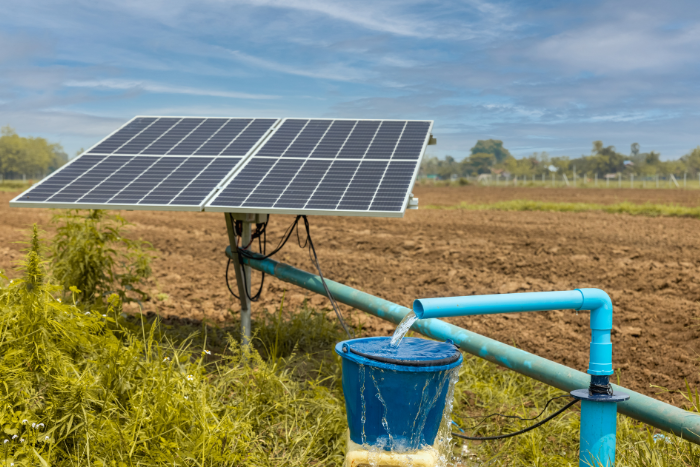India’s solar agriculture scheme launched by the government in 2019 is at a crossroads, the Centre for Science and Environment report said. The Pradhan Mantri Kisan Urja Suraksha Evam Utthaan Mahabhiyan (PM-KUSUM) scheme has achieved only 30% of its targets, and may miss its 2026 deadline, the research pointed out.
It provides an in-depth analysis based on surveys conducted in Haryana, Punjab, Rajasthan and Chhattisgarh, shedding light on the scheme’s on-ground realities and suggesting a comprehensive roadmap for its successful implementation.
The report explained that PM-KUSUM includes three parts. Component A: Installation of mini-grids on barren lands; B: Replacement of diesel water pumps with off-grid solar pumps; C: Replacement of electric water pumps with on-grid solar water pumps and installation of mini-grids for agriculture feeder solarisation.
The report shows that Component B has seen significant progress, particularly in Haryana, Rajasthan, Maharashtra and Uttar Pradesh, components A and C have lagged. Most implementation efforts have focused on replacing diesel pumps with solar variants, which has brought substantial benefits to farmers.
The report said the availability of cheap electricity, which diminishes the incentive for farmers to switch to solar pumps, has been a major hurdle. Farmers are often forced to opt for larger-than-needed pumps, increasing their financial burden.
Renewables capacity rise to 44% in total power mix in Q2 2024
India’s solar power accounted for 19.4% of the country’s total installed power capacity and 44.2% of the installed renewable capacity in the second quarter (Q2) of 2024, which is up from 15.9% and 38.4% year-on-year (YoY), respectively, Mercom reports.
The outlet added that India’s installed renewable energy capacity, including large hydro projects, stood at 196.4 GW at the end of Q2 2024, accounting for a 44% share of the overall power capacity mix, as per Central Electricity Authority (CEA). The total renewable energy (190.6 GW) share was 43.1% of the overall power mix at the end of Q1 2024.
Coal remained the top power source (211 GW) at the end of June 2024, and no new capacity was added during the quarter. The Centre, in May 2024, mandated coal-based thermal power projects should incorporate a 5% blend of biomass pellets annually.
Rajasthan becomes first to get 50% solar in its total installed power mix
Rajasthan achieved over 50% solar in its total installed power capacity, becoming the first state in India to do so, according to Mercom.
The sun-rich state has approximately 23 GW of solar capacity, representing 51% of its total installed power capacity, wrote the outlet, adding that solar energy also dominates Rajasthan’s renewable portfolio, accounting for 76% of its total installed renewable energy capacity.
The report added that in 2022, Rajasthan became the first state in India to surpass 10 GW of cumulative large-scale solar installations. Rajasthan is the top solar state in India, housing a quarter of India’s cumulative large-scale solar capacity.
The Mercom report pointed out that the state provides major sops to industry to set up solar installations such as concessional rates on stamp duty and registration charges for land transactions related to solar energy projects. This significantly reduces the upfront costs for developers. Rajasthan provides exemption from land tax for land used to develop solar projects. This exemption applies for the duration of the project’s operational life.
Renewable energy storage to rise to 6 GW by 2028 in India: CRISIL
India is expected to install 6 GW of renewable energy (RE) storage capacity by 2028. This is a surge from less than 1 GW operational as of March 2024, driven by a robust pipeline of projects under implementation and expected healthy pace of auctions, according to research agency CRISIL.
It added that such an increase is crucial to sustainably absorb the rising share of RE in the country’s overall power generation mix. “Despite slow progress on project implementation, the government’s push to develop RE power and tariffs for round-the-clock renewable energy, discovered in the past two fiscals, being comparable with other sources of round the clock power — improves confidence around adoption,” it said.
About The Author
You may also like
Non-Fossil Fuels Generates One-Third of India’s Electricity in 2025
India on track to achieve 2030 clean energy target
India to add 45GW solar capacity in FY 2026: Study
Government Proposes for ALMM Expansion for Solar Backward Integration
China’s renewable energy expansion can fuel global energy transition: Report

